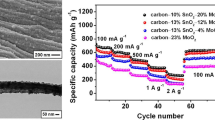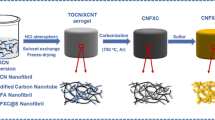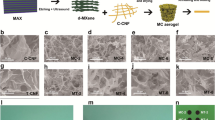Abstract
Cellulose has attracted attention as a biomass carbon precursor owing to its abundant reserves and unique properties such as a hierarchical fibrous structure and good mechanical properties. Here, we fabricate cellulose-derived carbon fibers via a facile electrospinning and carbonization process by using cellulose acetate precursor. The prepared carbon fibers are directly used as binder-free flexible anodes for Li ion batteries. They exhibit a high initial reversible specific capacity of 555 mA h g−1 with better cycling stability than carbonized commercial cellulose electrodes. To design extensive lithium storage electrodes, cellulose-derived carbon fiber/SnO2 composites are fabricated through electrospinning. In order to prevent the degradation of the active material, we encapsulate SnO2 nanoparticles in cellulose-derived carbon fibers with a large amount of SnO2 (46.4 wt%), which is evenly dispersed in the fibrous carbon matrix. Cellulose-derived carbon fiber/SnO2 electrodes reveal a high reversible capacity of 667 mA h g−1 and stable cycling retention of 76% over 100 cycles at 200 mA g−1, which signify much better cycling performance than commercial SnO2 nanoparticles. These properties are reflected in the advantages of cellulose-derived carbon fiber/SnO2 composite electrodes such as high reactivity, good mechanical properties, and high electrical conductivity that originate from the cellulose-based fibril nanostructure.
Graphical abstract









Similar content being viewed by others
References
Agubra VA et al (2016a) Forcespinning of polyacrylonitrile for mass production of lithium-ion battery separators. J Appl Polym Sci 42847:1–8. https://doi.org/10.1002/APP.42847
Agubra VA et al (2016b) Forcespinning: a new method for the mass production of Sn/C composite nanofiber anodes for lithium ion batteries. Solid State Ion. 286:72–82. https://doi.org/10.1016/j.ssi.2015.12.020
Agubra VA et al (2017) A comparative study on the performance of binary SnO2/NiO/C and Sn/C composite nanofibers as alternative anode materials for lithium ion batteries. Electrochim Acta 224:608–621. https://doi.org/10.1016/j.electacta.2016.12.054
Choi DI, Lee J-N, Song J, Kang P-H, Park J-K, Lee YM (2013) Fabrication of polyacrylonitrile/lignin-based carbon nanofibers for high-power lithium ion battery anodes. J Solid State Electrochem 17:2471–2475. https://doi.org/10.1007/s10008-013-2112-5
Deng L, Young RJ, Kinloch IA, Zhu Y, Eichhorn SJ (2013) Carbon nanofibres produced from electrospun cellulose nanofibres. Carbon 58:66–75. https://doi.org/10.1016/j.carbon.2013.02.032
Dursun B, Sar T, Ata A, Morcrette M, Akbas MY, Demir-Cakan R (2016) Pyrolyzed bacterial cellulose-supported SnO2 nanocomposites as high-capacity anode materials for sodium-ion batteries. Cellulose 23:2597–2607. https://doi.org/10.1007/s10570-016-0966-2
Farrukh S, Javed S, Hussain A, Mujahid M (2014) Blending of TiO2 nanoparticles with cellulose acetate polymer: to study the effect on morphology and gas permeation of blended membranes. Asia-Pac J Chem Eng 9:543–551. https://doi.org/10.1002/apj.1783
Guo ZP, Zhao ZW, Liu HK, Dou SX (2005) Electrochemical lithiation and de-lithiation of MWNT–Sn/SnNi nanocomposites. Carbon 43:1392–1399. https://doi.org/10.1016/j.carbon.2005.01.008
Han JT et al (2014) Extremely efficient liquid exfoliation and dispersion of layered materials by unusual acoustic cavitation. Sci Rep 4:5133. https://doi.org/10.1038/srep05133
He X (2017) Optimization of deacetylation process for regenerated cellulose hollow fiber membranes. Int J Polym Sci 2017:1–8. https://doi.org/10.1155/2017/3125413
Henry A, Louvain N, Fontaine O, Stievano L, Monconduit L, Boury B (2016) Synthesis of titania@carbon nanocomposite from urea-impregnated cellulose for efficient lithium and sodium batteries. Chemsuschem 9:264–273. https://doi.org/10.1002/cssc.201501561
Huang J, Kunitake T (2003) Nano-precision replication of natural cellulosic substances by metal oxides. J Am Chem Soc 125:11834–11835. https://doi.org/10.1021/ja037419k
Huang HB et al (2016) Hierarchical TiO2/C nanocomposite monoliths with a robust scaffolding architecture, mesopore–macropore network and TiO2-C heterostructure for high-performance lithium ion batteries. Nanoscale 8:10928–10937. https://doi.org/10.1039/c5nr09149g
Huang Y et al (2018) Preparation of bacterial cellulose based nitrogen-doped carbon nanofibers and their applications in the oxygen reduction reaction and sodium–ion battery. N J Chem 42:7407–7415. https://doi.org/10.1039/c8nj00708j
Ishimaru K, Hata T, Bronsveld P, Meier D, Imamura Y (2006) Spectroscopic analysis of carbonization behavior of wood, cellulose and lignin. J Mater Sci 42:122–129. https://doi.org/10.1007/s10853-006-1042-3
Jabbour L, Bongiovanni R, Chaussy D, Gerbaldi C, Beneventi D (2013) Cellulose-based Li-ion batteries: a review. Cellulose 20:1523–1545. https://doi.org/10.1007/s10570-013-9973-8
Ji L, Lin Z, Alcoutlabi M, Zhang X (2011) Recent developments in nanostructured anode materials for rechargeable lithium-ion batteries. Energy Environ Sci 4:2682–2699. https://doi.org/10.1039/c0ee00699h
Jia D, Li X, Huang J (2017) Bio-inspired sandwich-structured carbon/silicon/titanium-oxide nanofibers composite as an anode material for lithium-ion batteries. Compos Pt A Appl Sci Manuf 101:273–282. https://doi.org/10.1016/j.compositesa.2017.06.028
Jung D-W, Jeong J-H, Cha B-C, Kim J-B, Kong B-S, Lee JK, Oh E-S (2011) Effects of ball-milled graphite in the synthesis of SnO2/graphite as an active material in lithium ion batteries. Met Mater Int 17:1021–1026. https://doi.org/10.1007/s12540-011-6022-8
Kim T-S et al (2018) 3D Architectures of CoxP using silk fibroin scaffolds: an active and stable electrocatalyst for hydrogen generation in acidic and alkaline media. Small 1801284:1–9. https://doi.org/10.1002/smll.201801284
Lei W et al (2017) Highly nitrogen-doped three-dimensional carbon fibers network with superior sodium storage capacity. ACS Appl Mater Interfaces 9:28604–28611. https://doi.org/10.1021/acsami.7b08704
Li S, Wang M, Luo Y, Huang J (2016a) Bio-inspired hierarchical nanofibrous Fe3O4–TiO2-carbon composite as a high-performance anode material for lithium-ion batteries. ACS Appl Mater Interfaces 8:17343–17351. https://doi.org/10.1021/acsami.6b05206
Li Z, Liu J, Jiang K, Thundat T (2016b) Carbonized nanocellulose sustainably boosts the performance of activated carbon in ionic liquid supercapacitors. Nano Energy 25:161–169. https://doi.org/10.1016/j.nanoen.2016.04.036
Li Q et al (2017a) Growth of carbon nanotubes on electrospun cellulose fibers for high performance supercapacitors. Electrochem Soc 164(13):A3220–A3228
Li S et al (2017b) Carbonized cellulose paper as an effective interlayer in lithium-sulfur batteries. Appl Surf Sci 396:637–643. https://doi.org/10.1016/j.apsusc.2016.10.208
Li Z, Zhang J-w Yu, L-g Zhang J-w (2017c) Electrospun porous nanofibers for electrochemical energy storage. J Mater Sci 52:6173–6195. https://doi.org/10.1007/s10853-017-0794-2
Lingling Q, Xu T, Zhaofeng W, Xinshan P (2017) Pore characterization of different types of coal from coal and gas outburst disaster sites using low temperature nitrogen adsorption approach. J Min Sci Technol 27:371–377. https://doi.org/10.1016/j.ijmst.2017.01.005
Liu M, Ma X, Gan L, Xu Z, Zhu D, Chen L (2014) A facile synthesis of a novel mesoporous Ge@C sphere anode with stable and high capacity for lithium ion batteries. J Mater Chem A 2:17107–17114. https://doi.org/10.1039/c4ta02888k
Long C, Qi D, Wei T, Yan J, Jiang L, Fan Z (2014) Nitrogen-doped carbon networks for high energy density supercapacitors derived from polyaniline coated bacterial cellulose. Adv Funct Mater 24:3953–3961. https://doi.org/10.1002/adfm.201304269
Lou XW, Li CM, Archer LA (2009) Designed synthesis of coaxial SnO2@carbon hollow nanospheres for highly reversible lithium storage. Adv Mater 21:2536–2539. https://doi.org/10.1002/adma.200803439
Lu H, Sun X, Gaddam RR, Kumar NA, Zhao XS (2017) Electrocapacitive properties of nitrogen-containing porous carbon derived from cellulose. J Power Sources 360:634–641. https://doi.org/10.1016/j.jpowsour.2017.05.109
Nguyen VS, Rouxel D, Hadji R, Vincent B, Fort Y (2011) Effect of ultrasonication and dispersion stability on the cluster size of alumina nanoscale particles in aqueous solutions. Ultrason Sonochem 18:382–388. https://doi.org/10.1016/j.ultsonch.2010.07.003
Park S-W et al (2017) Superior lithium storage in nitrogen-doped carbon nanofibers with open-channels. Chem Eng J 315:1–9. https://doi.org/10.1016/j.cej.2017.01.005
Ruan C-Q, Wang Z, Lindh J, Stromme M (2018) Carbonized cellulose beads for efficient capacitive energy storage. Cellulose 25:3545–3556. https://doi.org/10.1007/s10570-018-1811-6
Schreiber M, Vivekanandhan S, Mohanty AK, Misra M (2014) Iodine treatment of lignin–cellulose acetate electrospun fibers: enhancement of green fiber carbonization. ACS Sustain Chem Eng 3:33–41. https://doi.org/10.1021/sc500481k
Shen D, Huang C, Gan L, Liu J, Gong Z, Long M (2018) Rational design of Si@SiO2/C composites using sustainable cellulose as a carbon resource for anodes in lithium-ion batteries. ACS Appl Mater Interfaces 10:7946–7954. https://doi.org/10.1021/acsami.7b16724
Silverstre-Albero AM et al (2018) Low-pressure hysteresis in adsorption: an artifact? J Phys Chem C 116:16652–16655. https://doi.org/10.1021/jp305358y
Song J, Birbach NL, Hinestroza JP (2012) Deposition of silver nanoparticles on cellulosic fibers via stabilization of carboxymethyl groups. Cellulose 19:411–424. https://doi.org/10.1007/s10570-011-9647-3
Tenhaeff WE et al (2013) Highly robust lithium ion battery anodes from lignin: an abundant, renewable, and low-cost material. Adv Funct Mater 24:1–9. https://doi.org/10.1002/adfm.201301420
Thorat GM, Jadhav HS, Chung W-J, Seo JG (2018) Collective use of deep eutectic solvent for one-pot synthesis of ternary Sn/SnO2@C electrode for supercapacitor. J Alloys Compd 732:694–704. https://doi.org/10.1016/j.jallcom.2017.10.176
Wang Z, Lu Z, Huang X, Xue R, Chen L (1997) Chemical and crystalline structure characterizations of polyfurfuryl alcohol pyrolyzed at 600 °C. Carbon 36:51–59. https://doi.org/10.1016/S0008-6223(97)00150-4
Wang J, Li L, Wong CL, Madhavi S (2012) Flexible single-walled carbon nanotube/polycellulose papers for lithium-ion batteries. Nanotechnology 23:495401. https://doi.org/10.1088/0957-4484/23/49/495401
Wang B et al (2013) Pyrolyzed bacterial cellulose: a versatile support for lithium ion battery anode materials. Small 9:2399–2404. https://doi.org/10.1002/smll.201300692
Wang M, Li S, Zhang Y, Huang J (2015) Hierarchical SnO2/Carbon nanofibrous composite derived from cellulose substance as anode material for lithium-ion batteries. Chem Eur J 21:16195–16202. https://doi.org/10.1002/chem.201502833
Wang H et al (2016) Composite melt-blown nonwoven fabrics with large pore size as Li-ion battery separator. Int J Hydrog Energy 41:324–330. https://doi.org/10.1016/j.ijhydene.2015.09.130
Wara NM, Francis LF, Velamakanni BV (1995) Addition aluminum to cellulose acetate membranes. J Membr Sci 104:43–49. https://doi.org/10.1016/0376-7388(95)00010-A
Warth H, Mülhaupt R, Schätzle J (1997) Thermoplastic cellulose acetate and cellulose acetate compounds prepared by reactive processing. J Appl Polym Sci 64:231–242. https://doi.org/10.1002/(SICI)1097-4628(19970411)64:2%3c231:AID-APP4%3e3.0.CO;2-S
Wei L, Sevilla M, Fuertes AB, Mokaya R, Yushin G (2011) Hydrothermal carbonization of abundant renewable natural organic chemicals for high-performance supercapacitor electrodes. Adv Energy Mater 1:356–361. https://doi.org/10.1002/aenm.201100019
Xia L, Wang S, Liu G, Ding L, Li D, Wang H, Qiao S (2016) Flexible SnO2/n-doped carbon nanofiber films as integrated electrodes for lithium-ion batteries with superior rate capacity and long cycle life. Small 12:853–859. https://doi.org/10.1002/smll.201503315
Xie W et al (2016) Fabrication of voids-involved SnO2@C nanofibers electrodes with highly reversible Sn/SnO2 conversion and much enhanced coulombic efficiency for lithium-ion batteries. J Power Sources 327:21–28. https://doi.org/10.1016/j.jpowsour.2016.07.030
Xu D et al (2016) A hierarchical n/s-codoped carbon anode fabricated facilely from cellulose/polyaniline microspheres for high-performance sodium-ion batteries. Adv Energy Mater 6:1501929. https://doi.org/10.1002/aenm.201501929
You X, Koda K, Yamada T, Uraki Y (2015) Preparation of electrode for electric double layer capacitor from electrospun lignin fibers. Holzforschung 69:1097–1106. https://doi.org/10.1515/hf-2014-0262
Zuniga L et al (2016) Multichannel hollow structure for improved electrochemical performance of TiO2/Carbon composite nanofibers as anodes for lithium ion batteries. J Alloys Compd 686:733–743. https://doi.org/10.1016/j.jallcom.2016.06.089
Acknowledgments
This work is supported by the National Research Foundation of Korea (NRF) Grant funded by the Ministry of Science and ICT (2016R1A2B2012728 and NRF-2018M3D1A1058744) and by the R &D Center for Valuable Recycling(Global-Top R&BD Program) of the Ministry of Environment (Project No.: R2-17-2016002250005).
Author information
Authors and Affiliations
Corresponding author
Additional information
Publisher's Note
Springer Nature remains neutral with regard to jurisdictional claims in published maps and institutional affiliations.
Electronic supplementary material
Below is the link to the electronic supplementary material.
Rights and permissions
About this article
Cite this article
Oh, SI., Kim, JC. & Kim, DW. Cellulose-derived tin-oxide-nanoparticle-embedded carbon fibers as binder-free flexible Li-ion battery anodes. Cellulose 26, 2557–2571 (2019). https://doi.org/10.1007/s10570-019-02258-7
Received:
Accepted:
Published:
Issue Date:
DOI: https://doi.org/10.1007/s10570-019-02258-7




